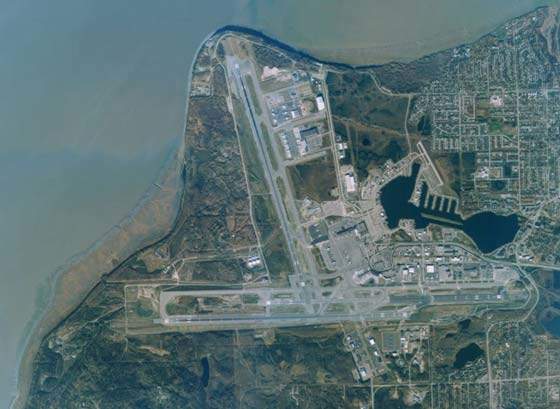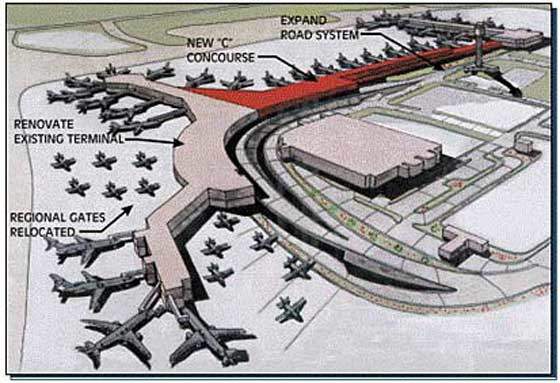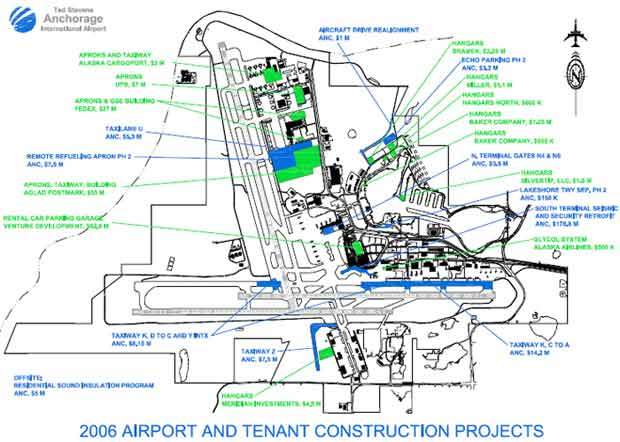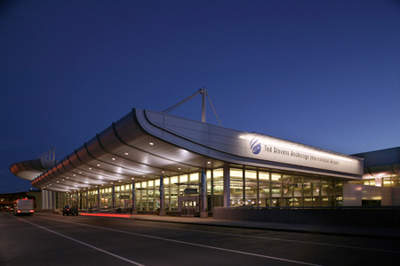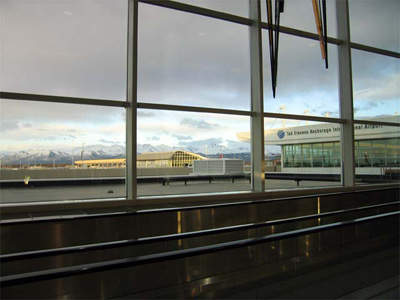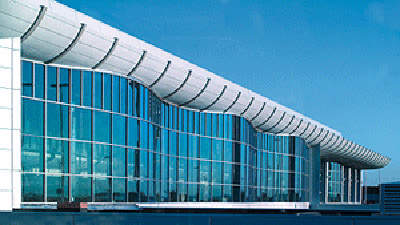Ted Stevens International Airport (renamed in 2000 in honour of Alaska’s senior US Senator) serves Anchorage in Alaska, the northernmost state in the USA (the airport is situated 12km south of the city). The terminals were over 45 years old and desperately needed upgrading to accommodate the passenger numbers using the airport.
The growth of traffic was in danger of seriously exceeding the airport’s capacity, but the upgrades had also become necessary due to changes in technical building requirements, particularly increased baggage checking and new regulations in the wake of the New York terror attacks. To handle these problems, in 1996, the State of Alaska Department of Transportation began to develop a long-term plan in conjunction with the airport.
Expansion of the airport was crucial to accommodate increasing numbers of both passenger and cargo flights (the airport is the third busiest for cargo in the world on tonnage and hosts 650 landings of widebodied aircraft each week).
ALASKA’S AIRPORT HUB
The airport provides an important hub in the region. Ted Stevens Anchorage International Airport is the gateway to Alaska’s largest city. It is also an important transpacific crossroads for both commercial and cargo flights.
The South Terminal hosts 17 airlines providing domestic flights including several flights to Hawaii to escape the cold Alaskan winters. The North Terminal houses four international airlines including China Airlines and Korean Air.
Although no flights presently link Anchorage and Russia, there are also plans to add flights to the Russian oil area of Sakhalin in the near future to meet the demands of US oil companies. Its domestic contribution for both cargo and passengers is invaluable.
ENVIRONMENTAL CONSIDERATIONS
The expansion project was undertaken with certain environmental factors in mind. These included concerns such as air quality, noise abatement, waste handling and the protection of wildlife.
Ted Stevens Anchorage International Airport has particular concerns in terms of weather conditions (an average of 5ft of snow a year), which make operating the airport more complicated.
The airport has the best snow-clearing teams in the world and there are few occasions through the winter season when the airport has to close due to adverse weather conditions.
The continuing health of the airport is important to the economy as a whole. It provides around 15,678 jobs in Anchorage as well as providing a vital ingress point for the tourism industry in the state.
The airport is essential to serve some of the northern towns and industries as workers and cargo are constantly ferried north.
EXPANSION PROGRAMME
The total expansion project had an overall cost of $230m, with the bulk of the cost ($103.7m) going into the replacement of the old concourse C. Terminal renovation accounted for a further $33.7m, roads and parking facilities $31.9m, air-side improvements $36m and the cost of arranging the finance package was estimated at $24.7m.
The project lasted six years, from 1999 to 2005. Some airlines were relocated in the first half of 1999 in preparation for the work, and construction began in the first quarter of 2000. Summer 2000 onwards was devoted to parking improvements, with the new exit road opening in the autumn of 2001.
The railroad construction contract was awarded in January 2001, and began work in April 2001. It was completed in late summer 2002 at the same time as the railway station.
RAILWAY CONSTRUCTION
The railway part of the project involved the construction of an approach tunnel connecting the railway terminus with the new concourse. The terminus was designed by McCool Carsen Green and Kumin Associates and the tunnel was designed by Kiewit Construction.
It is now operated by the local Alaskan Railway company. The design and construction cost an estimated $28m and was funded by the Federal Railroad Administration.
CONTRACTORS
The airport authority was able to make use of state-of-the-art remote sensing techniques (satellite and air surveying) in the planning of the expansion and update; this was provided by Grafton Technologies.
Parsons Brinckerhoff (PB) was awarded the contract for the management of construction in the airport. The existing concourse was demolished in order to make room for the new two-level concourse. Coffman Engineers provided structural engineering services for the replacement of the former concourse C and expansion of the existing south terminal. The international and domestic terminals are now connected at ground level.
Other elements included construction of new arrival and departure ramps, improved access and on-airport roadways, a new intermodal train station on an elevated platform, new cargo aircraft hardstands and refuelling facilities. In addition, a co-generation facility has been built to provide electricity and steam for the airport.
CONSTRUCTION OF CONCOURSE C
In September 2001, Kiewit Construction Company, a subsidiary of Kiewit Construction, was awarded a contract to build the new concourse C and arrivals hall. Under phase I, crews completed the construction of a structural steel frame and foundation for the terminal.
The $159.5m phase II work included limited demolition, concrete slab-on-grade and metal decks, structural and miscellaneous steel, fireproofing of 5,800t of structural steel framework, masonry, and 292,000ft² of exterior metal wall panels.
The contract also included new mechanical systems, a wide array of electrical equipment and systems, a state-of-the-art baggage handling system, a new taxiway, airline operations areas, concessions, restaurants, airport security, public transiting, restrooms, ticketing, check-in, baggage claim and Alaska’s first moving sidewalk.
CMI Architectural products provided the wavy curtain wall façade for the new concourse.
OPENING OF NEW CONCOURSE C
The new concourse C was opened by Ted Stevens in June 2004 (about one year ahead of schedule). The 447,200ft² concourse offers nine jet gates, increasing the South Terminal’s total size to 809,000ft². Alaska Airlines is leasing all nine gates.
Concourse C is designed to support flight and high-tech aviation and incorporates many natural materials from Alaska. A large central area with high sculpted ceilings, skylights and large surrounding windows houses the passenger security checkpoint and concession hall.
The terminal has 56,000ft² of exterior glass allowing sweeping views of the Chugach Mountains, downtown Anchorage, airside operations and the Alaska mountain range. To increase circulation along the 1,000ft concourse, the state’s first moving sidewalk transports passengers nearly 300ft along a wavy exterior glass wall.
FUNDING
The new airport expansion was funded mainly by State of Alaska revenue bonds ($179.2m), the Federal Highway Administration (FHWA)($26.3m) and the Federal Aviation Administration (FAA), who issued bonds for slightly less than the FHWA for repayment over a ten-year period.
FURTHER IMPROVEMENT WORK
In the third quarter of 2006 the airport started its seismic retrofitting project for concourses A and B. The project is due to bring the concourses into compliance with current seismic, heating, ventilation, electrical and safety codes.
In addition, airport customers will benefit from new baggage belt systems, expansion of passenger gate lounges and ticket lobby renovations. This is a long-term project expected to be completed by 2010.
NEW MASTERPLAN
The airport is now working on a new masterplan, a document originally written back in 1971. Since then, there have been four updates, the last one being in 2002.
This masterplan will reflect industry changes, growth and operating priorities that have taken place and provide a road map to more accurately assess operational needs.
The first step has already been completed. ASCG Incorporated of Alaska was selected as the consulting team to help lead the masterplan update project. They have brought sub consultants, HNTB Corporation and DOWL Engineers onboard. This will be done using a two-part phased contract to assess the current state of the airport, identify new needs and then develop a plan.

